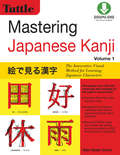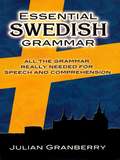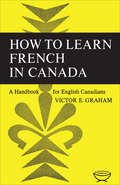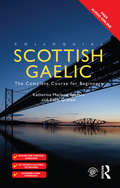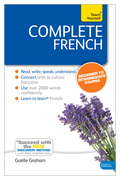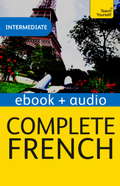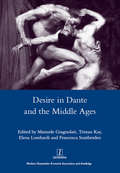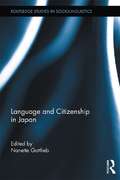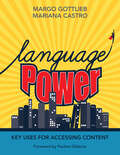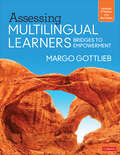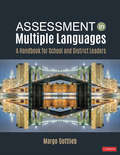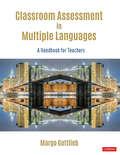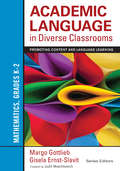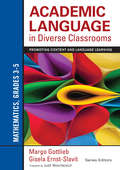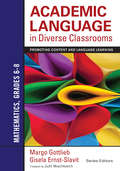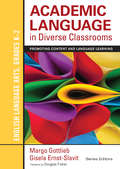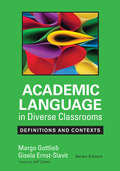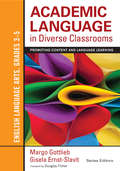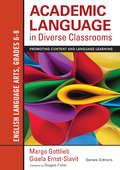- Table View
- List View
Mastering Japanese Kanji: The Innovative Visual Method for Learning Japanese Characters:1
by Glen Nolan GrantThis is a comprehensive, self-study workbook for learning Japanese characters.Mastering Japanese Kanji can help you greatly reduce the time and effort involved in learning to read Japanese and write Japanese.<P><P> It does so by introducing a method that is both effective and easy to use in memorizing the meanings and pronunciations of Kanji-the array of characters that are used in the Japanese language to symbolize everything from abstract ideas to concrete nouns.Learning any of the kanji is a two step process, requiring that you remember both the visual aspect of a character (so you can recognize it when you see it) and the aural aspect (so you will know how to say and, thus, read it). The method employed by Mastering Japanese Kanji will show you how to tackle both of these aspects from the outset, and by so doing enable you to immediately get down to the practical (and fun!) business of recognizing and reading kanji on everything from street signs to newspapers. By the time you finish this book, in fact you will be able to boast of a Japanese vocabulary numbering in the thousands of words.Key features: Downloadable material helps to reinforce the written materialTeaches the 200 most common kanji and the hundreds of compounds that use include them. Unique, specially-designed drawings and entertaining stories help you learn more quickly. Sample sentences, along with common words and compounds, expand your vocabulary by showing each kanji used in context. Stroke-order diagrams show the correct way to write each chapter. Chapter and cumulative review exercises help ensure master of what you've learned. Complete indexes show Japanese readings and English meanings for all Kanji.
Essential Swedish Grammar (Dover Language Guides Essential Grammar)
by Julian GranberryDesigned for those with limited learning time, this book is not a condensed outline of all aspects of Swedish grammar. Rather, it focuses on simple everyday communication, helping students use previously learned phrases and vocabulary more effectively and with great versatility.After introductory discussions of vocabulary building, word order and the formation of negative sentences and questions, the author offers concise, easy-to-follow coverage of the parts of speech. Numerous examples are included to demonstrate each rule of grammatical usage with the emphasis throughout on simple constructions rather than complicated ones. A selection of useful expressions and a glossary of grammatical terms round out this excellent, inexpensive guide, perfect for self-study or as an adjunct to a language course.Whether you are just beginning the study of Swedish or wish to review the fundamentals, Essential Swedish Grammar enables you to learn in a systematic way, at your own rate, guided by your own requirements and interests.
How to Learn French in Canada: A Handbook for English Canadians
by Victor E GrahamIt is well known that even after several years' exposure to high-school French, most English Canadians remain unable to speak the language. It is equally well known that many French Canadians are bilingual. One of the more obvious explanations for this relative deficiency on the part of the English Canadian is his lack of opportunities to use the French language in day-to-day situations, and, conversely, the French Canadian's need to know the second language, too often perhaps for economic reasons. Professor Graham's book gives useful and practical suggestions on how to go about becoming fluent in French. It offers not a course of instruction, but a listing of practical ways of applying oneself to a study of the language. There is specific, up-to-date information and advice regarding services provided by the governments of Quebec and France, courses offered in various Canadian communities, clubs and societies, correspondence courses, universities and summer schools, and language laboratories. A feature which will be especially helpful for those in remote areas is the listing of publications (books, newspapers, and periodicals), music and songs, records, films, and radio and television programmes which provide instruction in French. The reader will quickly see that the available means are much more varied than he realizes, and it is in providing this concise, convenient enumeration of them that Professor Graham performs a great service. Any adult who is reasonably proficient in French, but wishes to improve, will find this a practical and useful guide to ways of making a personal contribution to bilingualism in Canada. This study has been prepared under the sponsorship of the Canadian Association for Adult Education.
Colloquial Scottish Gaelic: The Complete Course for Beginners (Colloquial Ser.)
by Katie Graham Katherine M SpadaroColloquial Scottish Gaelic provides a step-by-step course in Scottish Gaelic as it is written and spoken today. Combining a user-friendly approach with a thorough treatment of the language, it equips learners with the essential skills needed to communicate confidently and effectively in Scottish Gaelic in a broad range of situations. No prior knowledge of the language is required. Key features include: progressive coverage of speaking, listening, reading and writing skills structured, jargon-free explanations of grammar an extensive range of focused and stimulating exercises realistic and entertaining dialogues covering a broad variety of scenarios useful vocabulary lists throughout the text an overview of the sounds and alphabet of Scottish Gaelic additional resources available at the back of the book, including a full answer key, a grammar summary, bilingual glossaries and English translations of dialogues. Balanced, comprehensive and rewarding, Colloquial Scottish Gaelic will be an indispensable resource both for independent learners and for students taking courses in Scottish Gaelic. Audio material to accompany the course is available to download free in MP3 format from www.routledge.com/cw/colloquials. Recorded by native speakers, the audio material features the dialogues and texts from the book and will help develop your listening and pronunciation skills.
Complete French (Learn French with Teach Yourself): New edition
by Gaelle GrahamComplete French is a comprehensive language course that takes you from beginner to intermediate level.This ebook just features text. An ebook + audio edition is also available with the ISBN 9781444154719.The new edition of this successful course has been fully revised and is packed with new learning features to give you the language, practice and skills to communicate with confidence.-Maps from A1 to B2 of the Common European Framework of Reference (CEFR) for languages-25 learning units plus revision unit and grammar summary-Discovery Method - figure out rules and patterns to make the language stick-Teaches the key skills - reading, writing, listening and speaking-Learn to learn - tips and skills on how to be a better language learner-Culture notes - learn about the people and places of France-Outcomes-based learning - focus your studies with clear aims-Authentic listening activities - everyday conversations give you a flavour of real spoken French-Test Yourself - see and track your own progressRely on Teach Yourself, trusted by language learners for over 75 years.
Complete French (Learn French with Teach Yourself): Enhanced eBook: New edition
by Gaelle GrahamComplete French is a comprehensive ebook + audio language course that takes you from beginner to intermediate level.The new edition of this successful course has been fully revised and is packed with new learning features to give you the language, practice and skills to communicate with confidence.-Maps from A1 to B2 of the Common European Framework of Reference (CEFR) for languages-25 learning units plus revision unit and grammar summary-Discovery Method - figure out rules and patterns to make the language stick-Teaches the key skills - reading, writing, listening and speaking-Learn to learn - tips and skills on how to be a better language learner-Culture notes - learn about the people and places of France-Outcomes-based learning - focus your studies with clear aims-Authentic listening activities - everyday conversations give you a flavour of real spoken French-Test Yourself - see and track your own progressRely on Teach Yourself, trusted by language learners for over 75 years.
Complete French (Learn French with Teach Yourself)
by Gaelle GrahamComplete French is a comprehensive language course that takes you from beginner to intermediate level.This ebook just features text. An ebook + audio edition is also available with the ISBN 9781444154719.The new edition of this successful course has been fully revised and is packed with new learning features to give you the language, practice and skills to communicate with confidence.-Maps from A1 to B2 of the Common European Framework of Reference (CEFR) for languages-25 learning units plus revision unit and grammar summary-Discovery Method - figure out rules and patterns to make the language stick-Teaches the key skills - reading, writing, listening and speaking-Learn to learn - tips and skills on how to be a better language learner-Culture notes - learn about the people and places of France-Outcomes-based learning - focus your studies with clear aims-Authentic listening activities - everyday conversations give you a flavour of real spoken French-Test Yourself - see and track your own progressRely on Teach Yourself, trusted by language learners for over 75 years.
Complete French (Learn French with Teach Yourself): Enhanced eBook: New edition
by Gaelle GrahamComplete French is a comprehensive ebook + audio language course that takes you from beginner to intermediate level.The new edition of this successful course has been fully revised and is packed with new learning features to give you the language, practice and skills to communicate with confidence.-Maps from A1 to B2 of the Common European Framework of Reference (CEFR) for languages-25 learning units plus revision unit and grammar summary-Discovery Method - figure out rules and patterns to make the language stick-Teaches the key skills - reading, writing, listening and speaking-Learn to learn - tips and skills on how to be a better language learner-Culture notes - learn about the people and places of France-Outcomes-based learning - focus your studies with clear aims-Authentic listening activities - everyday conversations give you a flavour of real spoken French-Test Yourself - see and track your own progressRely on Teach Yourself, trusted by language learners for over 75 years.
Desire in Dante and the Middle Ages
by Manuele GragnolatiThis volume takes Dante's rich and multifaceted discourse of desire, from the Vita Nova to the Commedia, as a point of departure in investigating medieval concepts of desire in all their multiplicity, fragmentation and interrelation. As well as offering several original contributions on this fundamental aspect of Dante's work, it seeks to situate the Florentine more effectively within the broader spectrum of medieval culture and to establish greater intellectual exchange between Dante scholars and those from other disciplines. The volume is also notable for its openness to diverse critical and methodological approaches. In considering the extent to which modern theoretical paradigms can be used to shed light upon the Middle Ages, it will interest those engaged with questions of critical theory as well as medieval culture.
Language and Citizenship in Japan (Routledge Studies in Sociolinguistics)
by Nanette GottliebThe relationship between language and citizenship in Japan has traditionally been regarded as a fixed tripartite: ‘Japanese citizenship’ means ‘Japanese ethnicity,’ which in turn means ‘Japanese as one’s first language.’ Historically, most non-Japanese who have chosen to take out citizenship have been members of the ‘oldcomer’ Chinese and Korean communities, born and raised in Japan. But this is changing: the last three decades have seen an influx of ‘newcomer’ economic migrants from a wide range of countries, many of whom choose to stay. The likelihood that they will apply for citizenship, to access the benefits it confers, means that citizenship and ethnicity can no longer be assumed to be synonyms in Japan. This is an important change for national discourse on cohesive communities. This book’s chapters discuss discourses, educational practices, and local linguistic practices which call into question the accepted view of the language-citizenship nexus in lived contexts of both existing Japanese citizens and potential future citizens. Through an examination of key themes relating both to newcomers and to an older group of citizens whose language practices have been shaped by historical forces, these essays highlight the fluid relationship of language and citizenship in the Japanese context.
Language Power: Key Uses for Accessing Content
by Margo Gottlieb Mariana CastroHere, at last, is every K-8 teacher’s playbook on the critical role academic language plays in content learning and student achievement. What exactly is so different? Margo Gottlieb and Mariana Castro distill the complexities of language learning into four key uses through which students can probe the interplay between language and content, then demonstrate their knowledge and understanding. It’s as straight-forward as that.
Language Power: Key Uses for Accessing Content
by Margo Gottlieb Mariana CastroHere, at last, is every K-8 teacher’s playbook on the critical role academic language plays in content learning and student achievement. What exactly is so different? Margo Gottlieb and Mariana Castro distill the complexities of language learning into four key uses through which students can probe the interplay between language and content, then demonstrate their knowledge and understanding. It’s as straight-forward as that.
Assessing Multilingual Learners: Bridges to Empowerment
by Margo GottliebEmpowering multilingual learners, families, and teachers With its emphasis on relationship building as the backdrop for linguistically and culturally sustainable assessment, the bestselling second edition of Assessing Multilingual Learners significantly impacted the field of language education. Applying the groundbreaking assessment "as," "for," and "of" learning model to new contexts, this updated third edition offers educators welcoming and encouraging ways to support multilingual learners to succeed in school and beyond. Through eight thoroughly revised chapters, Dr. Margo Gottlieb ties assessment to teaching and learning to foster agency and empowerment for multilingual learners, families, and teachers. This book envisions assessment as a process integral to and embedded in curriculum and instruction through: Assets-based language Student-centered activities Classroom assessment tools Portraits of practice illustrating authentic assessment practices References and resources for stimulating discussion Deep questioning for thinking through processes, dilemmas, or challenges Assessing Multilingual Learners explores the realities and possibilities of classroom assessment as a road to inspire multilingual learners, their families, and teachers to reach great heights.
Assessing Multilingual Learners: Bridges to Empowerment
by Margo GottliebEmpowering multilingual learners, families, and teachers With its emphasis on relationship building as the backdrop for linguistically and culturally sustainable assessment, the bestselling second edition of Assessing Multilingual Learners significantly impacted the field of language education. Applying the groundbreaking assessment "as," "for," and "of" learning model to new contexts, this updated third edition offers educators welcoming and encouraging ways to support multilingual learners to succeed in school and beyond. Through eight thoroughly revised chapters, Dr. Margo Gottlieb ties assessment to teaching and learning to foster agency and empowerment for multilingual learners, families, and teachers. This book envisions assessment as a process integral to and embedded in curriculum and instruction through: Assets-based language Student-centered activities Classroom assessment tools Portraits of practice illustrating authentic assessment practices References and resources for stimulating discussion Deep questioning for thinking through processes, dilemmas, or challenges Assessing Multilingual Learners explores the realities and possibilities of classroom assessment as a road to inspire multilingual learners, their families, and teachers to reach great heights.
Assessment in Multiple Languages: A Handbook for School and District Leaders
by Margo GottliebAssessing the full capabilities of your multilingual learners Assessment as, for, and of learning complement effective curricular and instructional practices, however, the complexities of assessment for multilingual students are too-often overlooked and misunderstood. What if multilingual learners, teachers, and educational leaders all had opportunities to plan for and use assessment data in multiple languages? Imagine the linguistic, academic, and cultural reservoirs we could tap to highlight what our multilingual learners know and can do. Assessment in Multiple Languages: A Handbook for School and District Leaders shows how superintendents, principals, directors, coaches, and other educational leaders can more accurately portray the academic, language, and social-emotional development of multilingual students. As a companion to Classroom Assessment in Multiple Languages, this book illustrates how the assessment cycle unfolds at school and district levels. Together the two books provide comprehensive guidance for enacting linguistically and culturally sustainable assessment in multiple languages in K-12 settings. Grounded in leading-edge research, with an emphasis on instilling equity and social justice in assessment practices, this book: justifies the legitimacy of assessment in multiple languages showcases examples from federal to classroom levels provides practical guidance and tools for schoolwide and district level assessment applies to any and all programs with multilingual learners whether in dual-language immersion, bilingual, or monolingual settings. Written by leading multilingual education and assessment authority Margo Gottlieb, this guide will help educational leaders highlight the true capabilities of multilingual learners.
Assessment in Multiple Languages: A Handbook for School and District Leaders
by Margo GottliebAssessing the full capabilities of your multilingual learners Assessment as, for, and of learning complement effective curricular and instructional practices, however, the complexities of assessment for multilingual students are too-often overlooked and misunderstood. What if multilingual learners, teachers, and educational leaders all had opportunities to plan for and use assessment data in multiple languages? Imagine the linguistic, academic, and cultural reservoirs we could tap to highlight what our multilingual learners know and can do. Assessment in Multiple Languages: A Handbook for School and District Leaders shows how superintendents, principals, directors, coaches, and other educational leaders can more accurately portray the academic, language, and social-emotional development of multilingual students. As a companion to Classroom Assessment in Multiple Languages, this book illustrates how the assessment cycle unfolds at school and district levels. Together the two books provide comprehensive guidance for enacting linguistically and culturally sustainable assessment in multiple languages in K-12 settings. Grounded in leading-edge research, with an emphasis on instilling equity and social justice in assessment practices, this book: justifies the legitimacy of assessment in multiple languages showcases examples from federal to classroom levels provides practical guidance and tools for schoolwide and district level assessment applies to any and all programs with multilingual learners whether in dual-language immersion, bilingual, or monolingual settings. Written by leading multilingual education and assessment authority Margo Gottlieb, this guide will help educational leaders highlight the true capabilities of multilingual learners.
Classroom Assessment in Multiple Languages: A Handbook for Teachers
by Margo GottliebWhat if multilingual learners had the freedom to interact in more than one language with their peers during classroom assessment? What if multilingual learners and their teachers in dual language settings had opportunities to use assessment data in multiple languages to make decisions? Just imagine the rich linguistic, academic, and cultural reservoirs we could tap as we determine what our multilingual learners know and can do. Thankfully, Margo Gottlieb is here to provide concrete and actionable guidance on how to create assessment systems that enable understanding of the whole student, not just that fraction of the student who is only visible as an English learner. With Classroom Assessment in Multiple Languages as your guide, you’ll: Better understand the rationale for and evidence on the value and advantages of classroom assessment in multiple languages Add to your toolkit of classroom assessment practices in one or multiple languages Be more precise and effective in your assessment of multilingual learners by embedding assessment as, for, and of learning into your instructional repertoire Recognize how social-emotional, content, and language learning are all tied to classroom assessment Guide multilingual learners in having voice and choice in the assessment process Despite the urgent need, assessment for multilingual learners is generally tucked into a remote chapter, if touched upon at all in a book; the number of resources narrows even more when multiple languages are brought into play. Here at last is that single resource on how educators and multilingual learners can mutually value languages and cultures in instruction and assessment throughout the school day and over time. We encourage you to get started right away. "Margo Gottlieb has demonstrated why the field, particularly the field as it involves the teaching of multilingual learners, needs another assessment book, particularly a book like this. . . . Classroom Assessment in Multiple Languages quite likely could serve as a catalyst toward the beginning of an enlightened discourse around assessment that will benefit multilingual learners." ~Kathy Escamilla
Classroom Assessment in Multiple Languages: A Handbook for Teachers
by Margo GottliebWhat if multilingual learners had the freedom to interact in more than one language with their peers during classroom assessment? What if multilingual learners and their teachers in dual language settings had opportunities to use assessment data in multiple languages to make decisions? Just imagine the rich linguistic, academic, and cultural reservoirs we could tap as we determine what our multilingual learners know and can do. Thankfully, Margo Gottlieb is here to provide concrete and actionable guidance on how to create assessment systems that enable understanding of the whole student, not just that fraction of the student who is only visible as an English learner. With Classroom Assessment in Multiple Languages as your guide, you’ll: Better understand the rationale for and evidence on the value and advantages of classroom assessment in multiple languages Add to your toolkit of classroom assessment practices in one or multiple languages Be more precise and effective in your assessment of multilingual learners by embedding assessment as, for, and of learning into your instructional repertoire Recognize how social-emotional, content, and language learning are all tied to classroom assessment Guide multilingual learners in having voice and choice in the assessment process Despite the urgent need, assessment for multilingual learners is generally tucked into a remote chapter, if touched upon at all in a book; the number of resources narrows even more when multiple languages are brought into play. Here at last is that single resource on how educators and multilingual learners can mutually value languages and cultures in instruction and assessment throughout the school day and over time. We encourage you to get started right away. "Margo Gottlieb has demonstrated why the field, particularly the field as it involves the teaching of multilingual learners, needs another assessment book, particularly a book like this. . . . Classroom Assessment in Multiple Languages quite likely could serve as a catalyst toward the beginning of an enlightened discourse around assessment that will benefit multilingual learners." ~Kathy Escamilla
Academic Language in Diverse Classrooms: Promoting Content and Language Learning
by Dr Margo Gottlieb Gisela Ernst-SlavitMake every student fluent in the language of learning. The Common Core and ELD standards provide pathways to academic success through academic language. Using an integrated Curricular Framework, districts, schools and professional learning communities can: Design and implement thematic units for learning Draw from content and language standards to set targets for all students Examine standards-centered materials for academic language Collaborate in planning instruction and assessment within and across lessons Consider linguistic and cultural resources of the students Create differentiated content and language objectives Delve deeply into instructional strategies involving academic language Reflect on teaching and learning
Academic Language in Diverse Classrooms: Promoting Content and Language Learning
by Dr Margo Gottlieb Gisela Ernst-SlavitMake every student fluent in the language of learning. The Common Core and ELD standards provide pathways to academic success through academic language. Using an integrated Curricular Framework, districts, schools and professional learning communities can: Design and implement thematic units for learning Draw from content and language standards to set targets for all students Examine standards-centered materials for academic language Collaborate in planning instruction and assessment within and across lessons Consider linguistic and cultural resources of the students Create differentiated content and language objectives Delve deeply into instructional strategies involving academic language Reflect on teaching and learning
Academic Language in Diverse Classrooms: Promoting Content and Language Learning
by Dr Margo Gottlieb Gisela Ernst-SlavitMake every student fluent in the language of learning. The Common Core and ELD standards provide pathways to academic success through academic language. Using an integrated Curricular Framework, districts, schools and professional learning communities can: Design and implement thematic units for learning Draw from content and language standards to set targets for all students Examine standards-centered materials for academic language Collaborate in planning instruction and assessment within and across lessons Consider linguistic and cultural resources of the students Create differentiated content and language objectives Delve deeply into instructional strategies involving academic language Reflect on teaching and learning
Academic Language in Diverse Classrooms: Promoting Content and Language Learning
by Dr Margo Gottlieb Gisela Ernst-SlavitMake every student fluent in the language of learning. The Common Core and ELD standards provide pathways to academic success through academic language. Using an integrated Curricular Framework, districts, schools and professional learning communities can: Design and implement thematic units for learning Draw from content and language standards to set targets for all students Examine standards-centered materials for academic language Collaborate in planning instruction and assessment within and across lessons Consider linguistic and cultural resources of the students Create differentiated content and language objectives Delve deeply into instructional strategies involving academic language Reflect on teaching and learning
Academic Language in Diverse Classrooms: Definitions and Contexts
by Dr Margo Gottlieb Gisela Ernst-SlavitEnsure your school speaks the language of success! Since the introduction of the Common Core, schools realize the necessity for a deep understanding of academic language as a stepping stone to academic achievement. The expectations for more robust curriculum, instruction, and assessment require administrators, teachers, and students to retool for academic success. This companion volume to Margo Gottlieb and Gisela Ernst-Slavit’s six-book series on academic language provides a thorough overview of key concepts and effective practices. Optimized for curricular planning and in-classroom reference, with particular attention to linguistically and culturally diverse students, the book includes: Definitions and examples of the dimensions of academic language. A step-by-step template for teachers to incorporate academic language into their planning for student learning. Graphic models that illustrate academic language use across the content areas.
Academic Language in Diverse Classrooms: Promoting Content and Language Learning
by Dr Margo Gottlieb Gisela Ernst-SlavitMake every student fluent in the language of learning. The Common Core and ELD standards provide pathways to academic success through academic language. Using an integrated Curricular Framework, districts, schools and professional learning communities can: Design and implement thematic units for learning Draw from content and language standards to set targets for all students Examine standards-centered materials for academic language Collaborate in planning instruction and assessment within and across lessons Consider linguistic and cultural resources of the students Create differentiated content and language objectives Delve deeply into instructional strategies involving academic language Reflect on teaching and learning
Academic Language in Diverse Classrooms: Promoting Content and Language Learning
by Dr Margo Gottlieb Gisela Ernst-SlavitMake every student fluent in the language of learning. The Common Core and ELD standards provide pathways to academic success through academic language. Using an integrated Curricular Framework, districts, schools and professional learning communities can: Design and implement thematic units for learning Draw from content and language standards to set targets for all students Examine standards-centered materials for academic language Collaborate in planning instruction and assessment within and across lessons Consider linguistic and cultural resources of the students Create differentiated content and language objectives Delve deeply into instructional strategies involving academic language Reflect on teaching and learning
